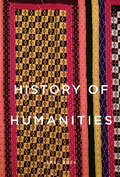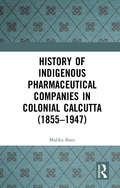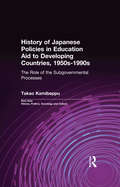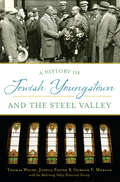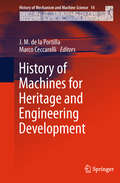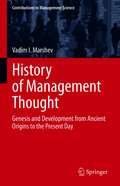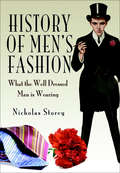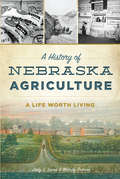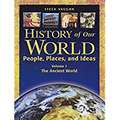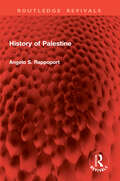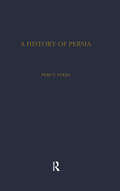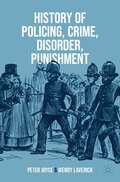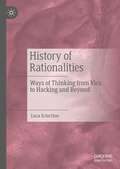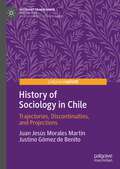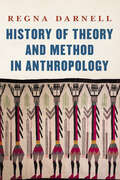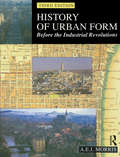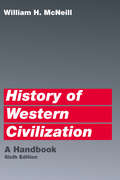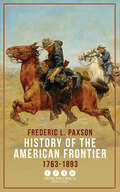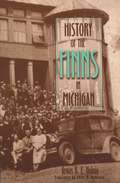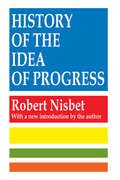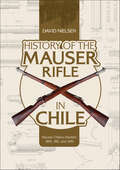- Table View
- List View
History of Humanities, volume 9 number 2 (Fall 2024)
by History of HumanitiesThis is volume 9 issue 2 of History of Humanities. History of Humanities, along with the Society for the History of the Humanities, takes as its subject the history of a wide variety of disciplines including archaeology, art history, historiography, linguistics, literary studies, musicology, philology, and media studies, tracing these fields from their earliest developments, through their formalization into university disciplines, and to the modern day. By exploring the history of humanities across time and civilizations and along with their sociopolitical and epistemic implications, the journal takes a critical look at the concept of humanities itself.
History of Indigenous Pharmaceutical Companies in Colonial Calcutta (1855–1947)
by Malika BasuIn the context of life and civilization, the pharmaceutical industry is as old as human existence. Since time immemorial India had its own enriched indigenous tradition of medicine. The development of alchemy and its application for human welfare was also an important step in Indian scientific tradition. The present monograph is an innovative attempt to understand the history of the indigenous pharmaceutical companies in Calcutta during the colonial times. Here pharmaceutical companies have been viewed as an illuminating lens to understand the interconnectedness between Indian traditions of thought and Western science and subsequent development of pharmaceutical industry in colonial India. The entire gamut of discussion centres around the issues of medical education, medical services, public health, pharmaceutical profession and politico-economic contexts of the development of pharmaceutical industry in colonial India. Three indigenous pharmaceuticals namely – Butto Krishna Paul & Co., Bengal Chemical & Pharmaceutical Works Limited, and East India Pharmaceutical Works Limited have been studied. The study not only portrays the politico-economic background to the emergence of the pharmaceutical industry in colonial India but links it to the economic nationalism and the quest for self-sufficiency among Indian nationalists and entrepreneurs. The pharmaceutical industry in India can be symbolic of a cultural response to modern science which was to pave the subsequent trajectory of national scientific endeavours in India.Please note: Taylor & Francis does not sell or distribute the Hardback in India, Pakistan, Nepal, Bhutan, Bangladesh and Sri Lanka.
History of Japanese Policies in Education Aid to Developing Countries, 1950s-1990s: The Role of the Subgovernmental Processes (East Asia: History, Politics, Sociology and Culture)
by Takao KamibeppuFirst published in 2002. Routledge is an imprint of Taylor & Francis, an informa company.
History of Jewish Youngstown and the Steel Valley, A (American Heritage)
by Thomas Welsh Gordon F. Morgan Joshua Foster The Mahoning Valley Historical SocietyFounded in the Mahoning Valley during 1837, a tiny settlement of secular German immigrants grew into one of the most influential centers of Jewish life in the Midwest. Home to nationally renowned rabbis and Zionist firebrands alike, the community produced an astonishing array of leaders in an impressive range of fields throughout the twentieth century. This notable legacy ranges from the entertainment juggernaut of Warner Brothers to the Arby’s fast-food empire and the prominent Youngstown Sheet & Tube, among many others. Authors Thomas Welsh, Joshua Foster and Gordon F. Morgan trace the unique history of one of Ohio’s oldest Jewish communities from its humble beginnings into the challenging climate of the new millennium.
History of Machines for Heritage and Engineering Development
by J. M. Portilla Marco CeccarelliThis volume contains a selection of papers whose content have been presented at the International conferences CIPHI on Cultural Heritage and History of Engineering at University of Las Palmas de Gran Canaria in the Canary Islands, Spain, in recent years. The conference series is aimed at bringing together researchers, scholars and students from a broad range of disciplines referring to the History of Engineering and Cultural Heritage, in a unique multidisciplinary forum to stimulate collaboration among historians, architects, restaurateurs, and engineers. These papers illustrate, by treating specific emblematic topics and problems, technical developments in the historical evolution of engineering concerning cultural heritage. Thus, emphasis is given to a discussion of matters of cultural heritage with engineering history by reporting authors' experiences and views. Topics treated include: reutilization of industrial heritage: the unique example of the Royal Segovia Mint in Spain; the image of factories; Pedro Juan De Lastanosa and "the twenty-one books of devices and machines of Juanelo"; the historical development of paper-mills and their machines in South Latium during 19th century; a virtual reconstruction of a wave-powered flour mill from 1801; 3D modelling and animation study of the industrial heritage wonders; a new model of the hydraulic machine known as "el artificio de Juanelo"; and the mystery of one Havana portrait, on the first steam machine in Cuba. This work has been made possible thanks to the invited authors who have enthusiastically shared this initiative and who have spent time and effort in preparing the papers in much more detail that in the conference presentations.
History of Management Thought: Genesis and Development from Ancient Origins to the Present Day (Contributions to Management Science)
by Vadim I. MarshevThis book describes the millennia-long process of the genesis, formation, struggle, and change of views on the management of social organizations in various countries around the world; in other words, it characterizes the worldwide evolution of the History of Management Thought (HMT) - ideas, concepts, theories, paradigms, and scientific schools - from Antiquity to the present. The book is the outcome of extensive research, based on the analysis, generalization, and systematization of foreign and domestic published literature, as well as on the gathering and analysis of unique archival materials. For the first time in the historical and managerial literature, the book puts forward original definitions of three historical and managerial sciences - the History of Management, the History of Management Thought, and the Historiography of Historical and Managerial Research. It addresses the main challenges in pursuing Historical and Scientific Research (HSR), the main “subject” levels of HSR and specific methodological problems concerning HMT, as well as epistemological methods for identifying key factors in and causes of the advent and evolution of HMT. This book presents both the origins of management thought dating back to the 5th millennium BC and the latest management concepts of the early 21st century. In particular, it traces the origins and sources of management thought, reflected in the works of thinkers and statesmen of the Ancient World (Egypt, Western Asia, China, India, Greece, and Rome), the era of feudalism, and the Middle Ages (Byzantium, Western Europe, and England), the era of inception capitalism (Western Europe and the USA), as well as the new and recent history of management thought of the 20th and 21st centuries. In addition, for the first time in History of Management literature, it presents the history of Russian management thought from the 9th century to modern concepts and scientific schools.
History of Men's Fashion: What the Well Dressed Man is Wearing
by Nicholas Storey&“Anyone aiming for timeless elegance, rather than temporary chic, will benefit from Storey&’s authoritative, but readable book.&” —Esquire Everything you ever wanted to know about men&’s clothing—and so much more—from the exact hour Nelson lost his right eye to the type of palm needed for a Panama hat, what Cary Grant&’s tailor had to do to his shoulders—and those all-important questions of what to where, when and why, including when to wear a bow tie (surely never is the only answer?). A quirky book full of facts that you never realised you needed to know, including the exact thickness of animal hair used to create must-have fashion items, including suits. Provocative, and controversial at times but always very well dressed. &“Mr. Storey, a barrister, offers a compendium of correct garments for all occasions, plus the best places to bespeak them, as well as anecdotes from films, books, royalty, and the beau monde . . . He solves every quandary, from proper &‘full-fig&’ (white tie) to the right (grey) topper for Ascot, to where to get and wear tweed. It is all here. Hats off.&” —Country Life &“Leaders of fashion all share one thing in common: a discerning penchant for the English sartorial standard. This book covers all the main areas rather well, just how Beau Brummell would have specified.&” —Maxim &“Pokes gentle fun at men&’s fashions through the last two centuries . . . This is popular history at its very best, amusing, entertaining, enlightening, and very, very funny . . . It&’s a brilliant book!&” —Books Monthly
History of Nebraska Agriculture, A: A Life Worth Living (American Heritage)
by Jody L. DobsonOnce known as the “Great American Desert,” Nebraska’s plains and native grasslands today make it a domestic leader in producing food, feed and fuel. From Omaha to Ogallala, Nebraska’s founding farmers, ranchers and agribusiness leaders endured hardships while fostering kinships that have lasted generations. While many continued on the trails leading west, others from around the world stayed, seeking a home and land to cultivate. American Doorstop Project co-founders and authors Jody L. Lamp and Melody Dobson celebrate the state’s forgotten and untold agricultural history, highlighting more than a century and a half of agriculture industry, inventions and innovations in the Cornhusker State.
History of Our World: People, Places, and Ideas (Volume 1 of the Ancient World)
by Henry BillingsLife for the earliest people was very different from life today. What if the things you use every day suddenly disappeared? Imagine your life without houses, cars, clothes, or books. How would you find food? How would you stay safe? These are questions that the earliest people faced. This unit tells how the earliest people answered those questions. To us, it might not seem like a big step to put a seed in the ground or a wheel on a cart. But for early people, each discovery was a huge step forward.
History of Palestine (Routledge Revivals)
by Angelo S. RappoportFirst published in 1931, History of Palestine is the dramatic picture of the Holy Land to which Jews returned after many centuries. The author has written the history of Palestine of 4000 years with the mind of the scholar and the heart of the religious mystic. Divided into three parts—pre-Israelite Palestine; Palestine, the promised land of the Hebrews; and Palestine, the holy land of Christendom, this book will appeal to students and researchers of history and general readers interested in the topic.
History of Persia (Routledge Library Editions)
by Sir Percy SykesThis is a facsimile of a classic history first published by Macmillan in 1915 and issued in two further editions by Routledge and Kegan Paul. Sir Percy Sykes was an explorer, consul, soldier and a spy who lived and travelled in Persia over a period of twenty-five years. This two-volume collection provides a comprehensive history of Persia from Alexander the Great, through British, French and Russian colonialism, to the early twentieth century oil industry.With a new introduction by Sykes' biographer, Antony Wynn, this comprehensive history provides essential background reading to students and academics of Persia.
History of Policing, Crime, Disorder, Punishment
by Peter Joyce Wendy LaverickThis engaging textbook provides a broad and unique coverage of the key historical events that shaped ideas in criminology, criminal justice and policing from the late seventeenth century to the early twenty-first century in England and Wales. It vividly illustrates the multi-disciplinary nature of criminology and penology by providing important insights into the social and political issues that shaped the development and operations of the criminal justice system and its responses to both crime and disorder. Using key text boxes, this book highlights key people, theorists, foundational principles and events throughout. Part One discusses the nature of crime and forms of punishment between 1689 and 1750 and the penological concerns regarding the aims of punishment. Part Two focuses on crime and disorder between 1750 and 1850, examining the impact of urbanization on criminal activity and it considers the background and state responses to key episodes of public disorder. Part Three covers the development of policing 1689-1856 and the contribution to policing made by reformers and the implementation of police reform. Part Four deals with a number of issues affecting crime and punishment between 1850 and 1920 including episodes such as Irish Home Rule within the context of ‘high policing’. It evaluates changes to the nature and role of prisons that occurred in this period. This student-friendly book contains end of chapter questions which summarise and enable further discussion.
History of Rationalities: Ways of Thinking from Vico to Hacking and Beyond
by Luca SciortinoOver time, philosophers and historians of science have introduced different notions of 'ways of thinking'. This book presents, compares, and contrasts these different notions. It focuses primarily on Ian Hacking’s idea of 'style of reasoning' in order to assess and develop it into a more systematic theory of scientific thought, arguing that Hacking’s theory implies epistemic relativism. Luca Sciortino also discusses the implications of Hacking’s ideas for the study of the problem of contingency and inevitability in the development of scientific knowledge
History of Sociology in Chile: Trajectories, Discontinuities, and Projections (Sociology Transformed)
by Juan Jesús Morales Martín Justino Gómez de BenitoThis book provides a comprehensive overview of the rich and diverse tradition of social thought in Chile over the last century. The authors emphasize the close relationship between sociology and society, and address large issues such as the institutionalization of sociology in the face of an open modernization process following WWII, the key role played by Chile in the regionalization and internationalization of sociology and social sciences in Latin America from the late 1950s until the 1973 Coup d'état, and the radicalization of sociology and the boom of dependency theories during that time. The analysis extends to independent academic centers that kept sociological thought, social intervention and the democratic dream alive within an authoritarian context, and the role of academic and professional sociology since the return to democracy, which has been attentive to accompanying and interpreting the development of a changing Chilean society. Framed within the country's cultural, economic, historical, social and political experience, this overview of the debates, dissemination, networks, and educational programs associated with sociology, will be of interest to students and scholars of Latin American studies and historical sociology.
History of Theory and Method in Anthropology (Critical Studies in the History of Anthropology)
by Regna DarnellRegna Darnell offers a critical reexamination of the theoretical orientation of the Americanist tradition, centered on the work of Franz Boas, and the professionalization of anthropology as an academic discipline in the United States in the late nineteenth and early twentieth centuries. History of Theory and Method in Anthropology reveals the theory schools, institutions, and social networks of scholars and fieldworkers primarily interested in the ethnography of North American Indigenous peoples. Darnell&’s fifty-year career entails foundational writings in the four fields of the discipline: cultural anthropology, ethnography, linguistics, and physical anthropology. Leading researchers, theorists, and fieldwork subjects include Claude Lévi-Strauss, Franz Boas, Benjamin Lee Whorf, John Wesley Powell, Frederica de Laguna, Dell Hymes, George Stocking Jr., and Anthony F. C. Wallace, as well as nineteenth-century Native language classifications, ethnography, ethnohistory, social psychology, structuralism, rationalism, biologism, mentalism, race science, human nature and cultural relativism, ethnocentrism, standpoint-based epistemology, collaborative research, and applied anthropology. History of Theory and Method in Anthropology is an essential volume for scholars and undergraduate and graduate students to enter into the history of the inductive theory schools and methodologies of the Americanist tradition and its legacies.
History of Ukraine - 2nd, Revised Edition
by Paul Robert MagocsiFirst published in 1996, A History of Ukraine quickly became the authoritative account of the evolution of Europe's second largest country. In this fully revised and expanded second edition, Paul Robert Magocsi examines recent developments in the country's history and uses new scholarship in order to expand our conception of the Ukrainian historical narrative.New chapters deal with the Crimean Khanate in the sixteenth and seventeenth centuries, and new research on the pre-historic Trypillians, the Italians of the Crimea and the Black Death, the Karaites, Ottoman and Crimean slavery, Soviet-era ethnic cleansing, and the Orange Revolution is incorporated. Magocsi has also thoroughly updated the many maps that appear throughout.Maintaining his depiction of the multicultural reality of past and present Ukraine, Magocsi has added new information on Ukraine's peoples and discusses Ukraine's diasporas. Comprehensive, innovative, and geared towards teaching, the second edition of A History of Ukraine is ideal for both teachers and students.
History of Urban Form Before the Industrial Revolution
by A.E.J. MorrisProvides an international history of urban development, from its origins to the industrial revolution. This well established book maintains the high standard of information found in the previous two editions, describing the physical results of some 5000 years of urban activity. It explains and develops the concept of 'unplanned' cities that grow organically, in contrast with 'planned' cities that were shaped in response to urban form determinants. Spread throughout the texts are copious illustrations from a wealth of sources, including cartographic urban records, aerial and other photographs, original drawings and the author's numerous analytical line drawings.
History of Western Civilization: A Handbook
by William H. McNeillRenowned historian William H. McNeil provides a brilliant narrative chronology of the development of Western civilization, representing its socio-political as well as cultural aspects. This sixth edition includes new material for the twentieth-century period and completely revised bibliographies. An invaluable tool for the study of Western civilization, the Handbook is an essential complement to readings in primary and secondary sources such as those in the nine-volume University of Chicago Readings in Western Civilization.
History of the American Frontier: 1763–1893
by Frederic L. PaxsonThough several historians had published works on America's westward expansion prior, Paxson's Pulitzer Prize winning study was groundbreaking in its complete and unified presentation. Beginning with a survey of the frontier at the end of the French and Indian War and proceeding to follow the frontier westward until the close of the period of settlement in about 1890, Paxson's cross-sectional method carries the narrative in a wide windrow of detail, serving as a detailed and scholarly synthesis of the fragmentary work of previous historians. An essential title for any study of American history.
History of the Finns in Michigan
by Armas K. E. Holmio Ellen M. RyynanenMichigan's Upper Peninsula was a major destination for Finns during the peak years of migration in the nineteenth century and the early decades of the twentieth century. Several Upper Peninsula communities had large Finnish populations and Finnish churches, lodges, cooperative stores, and temperance societies. Ishpeming and Hancock, especially, were important nationally as Finnish cultural centers. Originally published in Finnish in 1967 by Armas K. E. Holmio, History of the Finns in Michigan, translated into English by Ellen M. Ryynanen, brings the story of the contribution of Finnish immigrants into the mainstream of Michigan history. Holmio combines firsthand experience and personal contact with the first generation of Finnish immigrants with research in Finnish-language sources to create an important and compelling story of an immigrant group and its role in the development of Michigan.
History of the Idea of Progress
by Robert NisbetThe idea of progress from the Enlightenment to postmodernism is still very much with us. In intellectual discourse, journals, popular magazines, and radio and talk shows, the debate between those who are "progressivists" and those who are "declinists" is as spirited as it was in the late seventeenth century. In History of the Idea of Progress, Robert Nisbet traces the idea of progress from its origins in Greek, Roman, and medieval civilizations to modern times. It is a masterful frame of reference for understanding the present world.Nisbet asserts there are two fundamental building blocks necessary to Western doctrines of human advancement: the idea of growth, and the idea of necessity. He sees Christianity as a key element in both secular and spiritual evolution, for it conveys all the ingredients of the modern idea of progress: the advancement of the human race in time, a single time frame for all the peoples and epochs of the past and present, the conception of time as linear, and the envisagement of the future as having a Utopian end.In his new introduction, Nisbet shows why the idea of progress remains of critical importance to studies of social evolution and natural history. He provides a contemporary basis for many disciplines, including sociology, economics, philosophy, religion, politics, and science. History of the Idea of Progress continues to be a major resource for scholars in all these areas.
History of the Jews in Quebec (Canadian Studies)
by Pierre AnctilThe presence of Jews in Quebec dates back four centuries. Quebec Jewry, in Montreal in particular, has evolved over time, thanks to successive waves of migration from different regions of the world. The Jews of Quebec belong to a unique society in North America, which they have worked to fashion. The dedication with which they have defended their rights and their extensive achievements in multiple sectors of activity have helped foster diversity in Quebec. This work recounts the different contributions Jews have made over the years, along with the cultural context that encouraged the emergence in Montreal of a Jewish community like no other in North America. This is the first overview of a history that began during the French Regime and continued, through many twists and turns, up to the turn of the twenty-first century.
History of the Mauser Rifle in Chile: Mauser Chileno Modelo 1895, 1912, and 1935
by David NielsenThe acquisition history and the technical specifics of the Mauser rifles and carbines sold to Chile from 1895 to 1935
History of the Middle Ages: 300-1500
by James Westfall ThompsonFirst published in 1931, this book covers the broad period of time between the Christian Roman Empire instituted in the fourth century and the period of the Renaissance. The author traces the main events of medieval history — striking a balance between political, institutional, social and cultural history — with no event of major importance escaping recognition. In addition to covering medieval Europe in detail, it also includes sections on the Byzantine Empire and the foundation of Islam. Many maps are also included to geographically illustrate key points. This book will be of interest to students of history.
